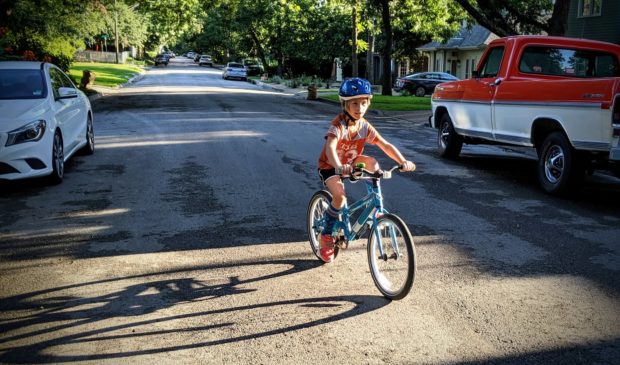Newsletter Signup
The Austin Monitor thanks its sponsors. Become one.
Most Popular Stories
- Latest State of Downtown report shows the city core’s businesses and housing are in transition
- Austin reopens applications for people who need help paying rent
- Watson is ahead in election for Austin mayor, but it’s unclear if he’ll avoid a runoff
- Nearly 52% of registered voters in Travis County cast an early ballot
- Updated: Austin Energy still considering options to answer to grid growing pains
-
Discover News By District

Community calls for ‘slow streets’ to take pressure off city parks and trails
Wednesday, April 29, 2020 by Ryan Thornton
Streets are closing to car traffic in cities from Salt Lake and Kansas City to Boston and Berlin to give people on foot and bicycle more room to get outdoors while keeping their distance from others during the Covid-19 health crisis.
The Austin Transportation Department has responded to the increased demand for safe street space with two projects of its own in recent weeks. The department has blocked cars from Riverside Drive alongside Auditorium Shores and converted a southbound traffic lane on the Longhorn Dam bridge to a path for walking and bicycling. Yet a large number of community organizations are calling for more action to protect residents.
The coalition, led by Walk Austin, is calling for miles of neighborhood streets to be retrofitted to prioritize walking and bicycling in order to allow for social distancing and necessary physical activity while relieving pressure being placed on city parks and trails. Their petition for an emergency “Slow Streets” program for the duration of the pandemic has collected hundreds of signatures since being posted Tuesday.
The city of Oakland has pioneered the charge for slow streets in the U.S. through its ambitious plan, announced early this month, to close approximately 74 miles of city streets to car through traffic in order to create more space for walking and biking while reserving residential vehicle access. In the weeks since, cities such as San Francisco, Denver, Louisville, and New York have made similar commitments.
Joanna Wolaver, board president of Austin Outside, said the proposal asks residents to participate by showing support and nominating appropriate neighborhood streets for closures. The streets are intended to be primarily low-traffic residential streets not on major corridors or public transit routes.
At the end of March, the National Association of City Transportation Officials published a set of rapid response tools for cities to manage the crisis that included relieving crowded spaces like trails and parks by opening certain streets to walking and bicycling. The list also mentions several other tools that the coalition is requesting: programming touch-activated pedestrian walk signals to run on an automatic cycle; building pop-up bike lanes on certain streets; and expanding space for walking near congested trails and sidewalks.
The petition also calls for more “leading pedestrian intervals,” walk signal programs that give people on foot a head start before motor vehicles are allowed to proceed through an intersection. Austin Transportation installed the intervals at more than 100 downtown intersections in January.
Some U.S. cities have rejected slow streets proposals, either out of fear of consequences or doubt of the need for such measures. In Portland, Oregon, some residents have resorted to “guerrilla” tactics of demarcating temporary bike lanes with traffic cones or chalk after the city’s transportation bureau decided opening streets could lead to unsafe social gatherings.
Chicago-based Active Transportation Alliance, a mobility advocacy group that otherwise supports open streets initiatives, posted a blog earlier this month saying “the context of a pandemic does not seem like the most appropriate moment to be pushing forward this vision.”
Some European cities, on the other hand, have taken this opportunity to make lasting changes to bicycle and pedestrian infrastructure to address the pandemic as well as the more sinister crisis of climate change. In order to prevent overcrowding on public transit while residents transition into their post-Covid-19 commutes, Milan has announced plans to mark off 22 miles of existing traffic lanes for walking and bicycling; the city of Brussels has plans to limit vehicle access to its city center and lower speeds to no more than 12 mph; and Paris is spending hundreds of millions to build 400 miles of bike lanes to aid in social distancing in the coming months and beyond.
Adam Greenfield, board president of Walk Austin, told the Austin Monitor that his group isn’t focused on any such long-term strategies, but noted his excitement at seeing how many Austinites are seeing and using streets differently.
“There is clearly a remarkable increase in walking and biking and it has created an appetite for change,” Greenfield said. “It’s quite common in Austin for people to drive walkable distances and I think this is going to change that.”
Greenfield clarified that this proposal would not be taking any streets away from cars: “There will be nowhere you can’t drive that you could drive before.” Rather, it would alleviate Covid-19’s impacts on physical and mental health while helping to lower the rate of transmission by giving people more safe space to move around.
Photo made available through a Creative Commons license.
The Austin Monitor’s work is made possible by donations from the community. Though our reporting covers donors from time to time, we are careful to keep business and editorial efforts separate while maintaining transparency. A complete list of donors is available here, and our code of ethics is explained here.
You're a community leader
And we’re honored you look to us for serious, in-depth news. You know a strong community needs local and dedicated watchdog reporting. We’re here for you and that won’t change. Now will you take the powerful next step and support our nonprofit news organization?









